by Elżbieta Witkowska-Zaremba
translated by Maria Pilatowicz
Dedicated to the memory of Prof. Jerzy Żurawlew
Abstract
The mazurkas – dance miniatures that Chopin composed throughout his entire creative life – constitute suitable material for an attempt at investigating the stylistic changes that occurred within the framework of a single genre. Only the mazurkas with opus numbers that were published during Chopin’s lifetime are considered in the present study. The methodological framework for the analysis of the genre is provided by theoretical principles of classical period form, accepted by Koch, Riepel, Marx and Riemann. The investigation centers on the combined action of the basic constituents of period-form, the syntax revealing themselves through Taktordnung with its own symmetry and segmentation that consitute a logical successor to the Taktordnung. In the mazurkas these constituents of the periodic form are treated in an individualized and differentiated manner which is coupled with a degree of relaxation of the connection between syntax and metrics, a connection that lies at the foundation of classical norms. The first element of periodicity to be thoroughly studied is the relationship of “antecedent- consequent.” Compositional devices which serve to obliterate this relationship – while retaining the other constituents of periodicity – may be observed from Op. 7 (1824-32) onwards. Op. 7 also reveals the first signs of a different procedure based on a weakening of the mid- period caesura with a simultaneous enhancement of the “antecedent-consequent” relationship. The compositional devices which serve to weaken, mask and display the mid-period caesura have enabled the construction of syntactic entities extending beyond the framework of the segmentation that results from the classical Taktordnung. The most subtle of these devices is slurring “against the phrase,” operating – in effect – against the fundamental constituents of periodicity and at times re-organizing the form of the composition. The final constituent of periodic structure to be reconsidered in the mazurkas is the Taktordnung and the binary principle organizing the basic tissue of the musical substance, and at the same time marking out the pulse of “periodic rhythm.” This principle was clearly undermined in Op. 56, no. 3 (1843-44).
The varied treatment of the individual constituents of periodic form determines the variety of the mazurkas within the genre. The emphasis on the “antecedent-consequent” relationship together with the simultaneous masking or displacement of the conclusion of the period, the expansion of the phrase and the disturbance of its rhythm lead to an increase in expression and a dramatization of form. The blurring of the “antecedent-consequent” relationship, on the other hand, with the simultaneous exposure of the metric factor leads to an abstraction of musical form. This variety announced its presence in the very earliest opus numbers, reached its widest range in Op. 41 (No.1 and No.2) and Op. 56 (No.2 and No.3) and was then significantly reduced in Op.59 and Op.63.
Article
Introduction
Chopin’s Mazurkas – 57 dance miniatures composed between 1824 and 1849 – are a musical collection where seemingly contradictory elements coexist in perfect harmony. Scholars have considered these works to be a manifestation of Polish ethnicity as well as a most personal form of expression; the homogeneity of form does not preclude the rich variety of content, originality, or uniqueness of style. Due to the fact that Chopin composed mazurkas during various stages of his creative life, the collective body of these compositions lends itself to a systematic analysis tracing the evolutionary changes of style in Chopin’s approach to this form. This study focuses upon musical categories highlighted in its title: versification, syntax, and form. Only compositions assigned an opus number and published during Chopin’s lifetime were considered and E. Zimmermann’s edition (Munich: Henle Verlag, 1975-78) served as the principal source of the music.
I.
The meaning of the term “syntax” applied in the present study corresponds to that used in the classical theory of periodic structure which epitomizes the ancient tradition of defining a musical passage as an analogy to verbal text and applying categories from the domains of rhetoric and grammar to the realm of music analysis. In accordance with these basic assumptions, the musical period——modeled after the grammatical period – represents on arrangement of various melodic segments, called sentences. These sentences, taken collectively, express one, complete idea, but in order to achieve closure a sequence of sentences must end with a perfect cadence. According to the theory of H. Charles Koch, the element which differentiates sentences within the period, and also provides it with closure is a cadence—treated here as an equivalent to punctuation in speech.[1] In addition to the cadence, which determines the period’s divisibility, another important characteristic of the musical period is its metro-rhythmic order, defined by the so-called Taktordung which states that a musical sentence should consist of not less than four measures. J. Riepl posits that the ideal dimensions of sentences and larger segments compounded of sentences should be based on the multiples of number four, e.g., eight, sixteen, and thirty-two measures. He also recommends the use of sentences that are twelve, twenty, and twenty-four measure long. [2]
The relationship between meter and syntax, which has already been established by treating the sentence as a melodic element, is based both on punctuation and on the number of measures, the latter being a metro-syntactical category and the foundation for Riemann’s norm of periodic structure. In his model, Riemann entirely subordinated meter to syntax. Within a continuous musical passage, he first distinguished an individual motif (ideally, corresponding to one measure) then a group of measures related to this motif (Taktgruppe which according to the standard, consists of two measures). Finally he defined groups of measures as semi-sentences (Vordersatz and Nachsatz ideally consisting of four measures) which, when joined, create an eight-measure sentence (Satz) identical to the period (Periode). Similar constructions may also be found in the work of the Chomińskis who, while elaborating on the principles of the periodic structure, refrain from specifying a metrical framework for its individual components.[3] While the Chomińskis emphasize the metro-rhythmical importance of the motif, they treat a phrase as a linkage of two or more motifs, with certain formative possibilities. The sentence, playing a fundamental role in partitioning a given musical form, usually consists of two or more phrases, whereas the period consists of two sentences placed in sequential order of an antecedent (Vordersatz) and a consequent (Nachsatz), two semi-sentences that have a “question-answer” relationship.
Riemann’s model of periodic structure with its characteristic symmetry finds a literary counterpart in the recurrent pattern of rhythmic prose, in which subsequent compound or complex sentences are of identical or approximately identical length; this phenomenon is known as “isokolism” (izokolizm in Polish).[4] In Chopin’s Mazurka’s where the metro-rhythmic element is, for obvious reasons, particularly important, the rhythm of the musical phrase corresponds to the “isokolism” described above. The rhythmic fluidity of these compositions, linked to a regular (repetitive) segmentation which is frequently identical with the classical Taktordnung, requires searching for structural analogies in poetry rather than in prose. The characteristic construction of Chopin’s mazurkas bears a closer resemblance to the strophic form of a poem than to the rhythmicized prose. This analogy is accentuated by the fact that the segments of the mazurkas that differ in terms of their syntax and function (thematic segments are obviously different from segments of a transitory character) maintain a generally uniform Taktordnung; thus in detailed analyses (for instance by Miketta) these segments are usually referred to as periods.[5]
The strophic structure is evident even when the make-up of individual segments deviates both from the classical norms of syntax (identified on the basis of the different types of cadences) as well as from the typical, “four-square”, or symmetrical, order of measures, Taktordnung. This case is best illustrated by the Mazurka in B major Op. 41 No. 2 (m. 1-38 and 55-78), where an abstract scheme of the “strophe” becomes a reference point for the unique, almost geometric construction of the outer segments (see Figure 1).
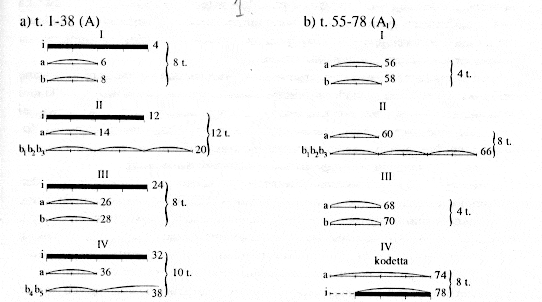
Occasionally a sixteen-measure segment, conforming to the norms of the classical Taktordnung and easily divisible into four-measure phrases, may lack a clear-cut punctuation. Such segments usually form a transparent structure with predominately metric-motoric qualities reminiscent of a perpetuum mobile. In the Mazurka in C major, Op. 7, No. 5, two symmetric and structurally uniform eight-measure segments are arranged in the modulation framework of G major – C major – A minor – D major – G major, which, as it were, “forces” the return to the key of C major, and consequently the repeat of the entire scheme senza fine. This process is made possible by the elimination of punctuation: the cadential caesuras (breaks), although easily identifiable, have been absorbed by the metric element without creating (to quote Koch) “Ruhepunkte des Geistes” [“resting points of the spirit”] so that the entire segment always remains open.
The expansion of the musical phrase may lead to quite different consequences; this compositional procedure serves the purpose of extending a given musical passage by increasing the durations of individual sounds or sonorities, introduction of additional material (“interpolacje”), extending the cadences, etc. According to William Rothstein, who studied the rhythmic phrasing of the nocturnes, this procedure is connected to Chopin’s works composed after 1840.[6] However, it seems that there are some earlier mazurkas that may serve as examples of the same compositional technique. In these pieces, the phenomena that disturb the rhythm of phrasing—and consequently also alter the regularity of the strophic structure—may be interpreted as an effect of assigning a dominant role to the syntactic element.
Hence, in mazurkas one may observe the diverse and individualized treatment of various factors of periodic structure—syntax (identifiable through the differentiation of cadences), characteristically symmetrical Taktordnung, and segmentation which theoretically appears to be a logical outgrowth of the Taktordnung. All this would not have been possible without a certain relaxation in the relationship between the syntax and the meter; this relationship is fundamental to the classical norm.
A closer insight into phenomena described above requires a more precise definition of several terms. We will use the term “segment” [człon] as a category of syntax, referring to the musical equivalent of either a subordinate or independent clause. Each section of a musical progression ending with the “punctuation mark” of the cadence that and serving as either a preceding (antecedent) or successive (consequent) component of the period will be called a “segment.” The term “period” [okres] will also be treated as a category of syntax, referring to the structure as a whole, and consisting of the antecedent and the consequent, two subordinate parts whose relationship corresponds to that of the “question—answer.” In full awareness of introducing a conceptual simplification, the term “phrase” will be used here as a metric category. Thus a “phrase” [fraza] will mean a section of the musical progression, that could serve as an equivalent to one poetic line (verse). A phrase may (but not necessarily on all occasions) correspond to a segment or its portion. An extended section, i.e., a metric unit consisting of a specific arrangement of phrases will be called a “strophe” [strofa] It is possible, but not required, that the strophe corresponds to the syntactic structure defined above as a period. Finally, the term “versification” will refer to all matters concerning the metric structure of strophes and the manner in which they are connected.
It is clear that the strophe is shaped through the simultaneous action of two fundamental normative principles: metric—responsible for the “quantitative” harmony expressed through the rhythm of the phrases, and syntactic—evident in cadences treated as elements of formal punctuation, as well as in a factor that is more difficult to define objectively, i.e., a subjective feeling of completion/closure derived from maintaining balance in the “question-answer” relationship. The great structural variety of strophes in Chopin’s mazurkas stems in a great extent from the diversity of relationships between these two principles: assigning the dominant role to one over the other, preserving the balance between them or, lastly, treating each principle as a discreet point of reference indispensable to maintaining the identity of the genre.
In addition to two main normative principles defined above, still another normative element appears in Chopin’s music: slurring [łukowanie] that works in conjunction with the metric and syntactic principles. The issue of slurring in Chopin’s work has been a subject of intense scrutiny by musicologists. It is generally known that the composer considered the slur to be of great significance and that he accepted different ways of using slurs within the same composition. Higgins and Rothstein have also established that Chopin’s slurs often function “against the phrase,” seemingly ruining the order of syntax.[7] The following detailed remarks on this subject are based on E. Zimmermann’s edition of the Mazurkas, with the assumption that it reflects one of the many ways of slurring the phrases in mazurkas authorized by Chopin. The slur—in its most general interpretation—should be treated as an indication pertaining to the “pattern of declamation” appearing in a given work. While undermining the clearly evident punctuation (thus undermining the certainty of its significance), the slur exposes elements which otherwise would have remained hidden in the shadows. When used to bridge longer distances or to join strophes and even larger segments, the slur can be an invaluable clue for interpretation and analysis of Chopin’s compositions.
The various ways in which these elements converge to shape the narrative style of the mazurkas unequivocally determine the means of coordinating and internally unifying the diverse segments creating the whole. Thus, they ultimately define the form of the musical work (and provide a musical reference to A.B. Marx’s theory of the musical form).[8]
II.
The dominant pattern of the strophe in many mazurkas (especially those carrying the main theme) is the sixteen-measure segment consisting of four four-measure phrases. This segment is analogous to the four-verse poetic strophe that mirrors the preferred Taktordnung of the classical minuet, also called vier Vierer [“four by four”] (see Budday 1983, p. 129). The eight-measure period extended to the length of the strophe usually serves as the syntactical core of such a segment.[8] The first part of the Mazurka in F-sharp minor, Op. 6, No. 1, m. 1-16
(analyzed by the Chomińskis) may provide an example of the precise balance between syntactic and metric factors (see Example 2).[9]
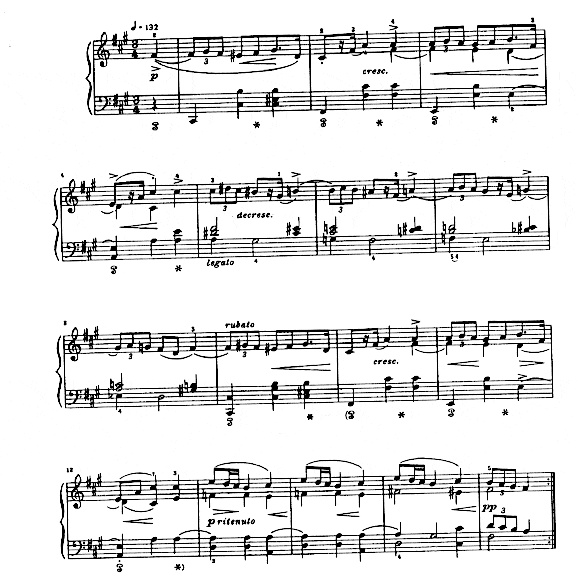
The metric and syntactic balance may also be achieved through the exact repetition of the eight-measure period (as in the Mazurka in C-sharp minor, Op. 6, No. 2, m. 9-16) or through the repetition with slight variations (e.g., Mazurka in G minor, Op. 24, No. 1, m. 1-16). The adaptation of syntax to the metric requirements of the strophe sometimes interferes with its symmetry, especially when only one of the segments of the period is subject to expansion. In the Mazurka in A-sharp minor, Op. 17, No. 3 (m. 1-16), the antecedent is stretched out to twelve measures through variational transformations. This expansion results in a syntactic ambiguity due to the neutralization of the caesura between the antecedent and the consequent (see Example 3).

A similar effect may be observed in the more metrically diversified twelve-measure strophes, among which the first segment of the Mazurka in B major, Op. 7, No. 1 (m. 1-12) stands out as an example.[10] It is composed of two three-measure phrases and three two-measure phrases. While the presence of a periodic structure in this segment is beyond question, the caesura between the antecedent and the consequent is ambiguous enough to be placed at the end of any of the first four verses of the strophe (see Example 4 and Figure 5).

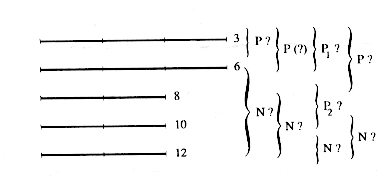
The syntax of the first segment of the Mazurka in A-flat major, Op. 24, No. 3 (m. 1-12) is ambiguous as well. [11] Heinrich Schenker identified in the harmonic progression of this segment three four-measure sections: (see Example 6).

Such partitioning indicates the presence of an eight-measure period with a repeated consequent (this type of the syntactical pattern also appears in the first segment of the Mazurka in E minor, Op. 17, No. 2, m. 1-12). Nonetheless, the melodic structure (2+4+4+2) suggests another possible manner of subdividing this work; this did not escape the attention of Miketta.[12] Both variants might be summarized in the following diagram: (see Figure 7).

The balance between the syntactic and metric elements evident in these examples is also revealed in the adjustment of the period’s segmentation to the dimensions of the strophe, as well as in the undisturbed rhythm of the phrase. All these features are harmonized with the static form of the mazurkas discussed here. In all the cases the form is cumulative, as it is based on the principle of addition of new segments and the creation of periods of higher order.[13] The distinguishing factor in all the individual segments—besides the obvious thematic diversity—is the structure of their strophes: segments B are usually eight measures long (4 + 4). Repetition is a typical means of integration of the individual segments; it usually results in the creation of a tri-partite overall formal plan. Although repetition joins strophes that differ both thematically and metrically and does so in a seemingly mechanical manner, in the process it presents theme A in a variety of contexts (see Figure 8).
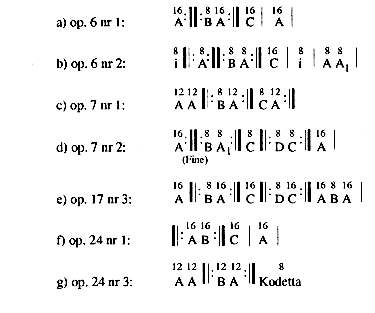
The cumulative, or additive form combined with such a mechanical repetition connecting two thematically different segments—the heritage of the stylized, classical dance—is a dominating principle of construction in Chopin’s Mazurkas, Opp. 6, 7 and 24. It also appears twice in Opus 17. In later works this type of repetition appeared in one instance only—in the middle section of Mazurka in A-flat major, Op. 50, No. 2. It seems, however, that on this occasion it served different formal principles. In this particular composition two distinct kinds of melodic material and textures are juxtaposed. The outer sections of the piece contain an extensive melodic line, developed along the latent contour of the twenty-measure, five-verse strophe, divided into 1:4 ratio by an slur. The slur, while masking the periodic punctuation, endows the melody with such continuity that it brings to mind the Wagnerian unendliche Melodie (as observed by Rothstein). In contrast, the middle section whose progression is regulated by a clearly articulated rhythmic pulse, highlighting the classic periodic syntax, almost seems to form an independent entity, based on the pattern of a mazurka “in the old style.”
III.
Besides the already defined cumulative or additive form, the early collections of mazurkas feature a different formative technique which strives to increase the dynamic character and dramatize the musical progression while expanding the size of the composition as well. This principle manifests itself in open segments which are frequently connected by the relationship of their motivic material, resulting in a particular continuity of narration. The earliest example of such a formative approach is the Mazurka in F minor, Op. 7, No. 3. It features the transparent periodic syntax of individual strophes which are arranged according to a clear, concise and comprehensive tonal scheme. Another integrating factor in this technique is versification based on the uniform rhythm of the four-verse strophe consisting of four-measure phrases. Through these means the composition acquires an epic character and is transformed into a kind of miniature ballad. The gradual dramatization of this category of compositions may be observed in the following mazurkas: Op. 17, No. 4; Op. 24, No. 4; Op. 30, No. 4; Op. 41, No. 4; Op. 50, No. 3; op 56, No. 3. The Mazurka in B minor, Op. 24, No. 4, presents a special case of the fusion of formative elements that characterize both techniques of construction (i.e., the additive form and the “open-segment” form). Here the repetition typical of the cumulative form, joining segments A and B (mm. 21-25) is coupled with certain irregularities in the structure of the strophe, due to the introduction of expressive elements characteristic of the narrative form.
The majority of elements serving to dramatize a musical passage derive from the sonata form; in the first half of the 19th century the sonata form was considered to be a musical reflection of drama. The use of contrasting themes and the placement of the “dramatic peak” immediately before the recapitulation rank among the most important dramatizing elements. In addition, the coda becomes a second “dramatic peak” in Chopin’s mazurkas.[14]
The segments of the mazurkas where the “dramatic peaks” arise, are foreshadowed by a gradual increase in irregularities in strophic structure due to the expansion of the phrases, elisions, etc. Thus, in the Mazurka in F minor, Op. 7, No. 3, the strophe preceding the return to the main theme was expanded to 5 verses (mm. 57-76). In the Mazurka in A minor, Op. 17, No. 4, the corresponding segment spans two sixteen-measure strophes (mm. 61-92). The caesura (mm. 76-77) between these strophes is weakened by the connecting slur. In a similar segment of the Mazurka in B-flat minor Op. 24, No. 4 (mm. 61-94), the strophic structure has been blurred through a much more effective compositional technique. In this method homogeneous thematic material is presented against a background of a mobile harmonic foundation, oscillating between the keys of D-flat major, D-flat minor (i.e., C-sharp minor), and E major. It has the effect of energizing the progression and suffusing the entire segment with a developmental character. The structure of the strophe in this segment as well as the rhythm of the phrase are disturbed two times through the interruption of the harmonic progression after reaching the dominant. In the first instance (m. 73-80)—in view of the delayed appearance of the tonic— the strophe is extended to twenty measures. In the second case (mm. 89-94)—where the progression is halted on the dominant—two measures are missing from the complete strophe (see Figure 9).
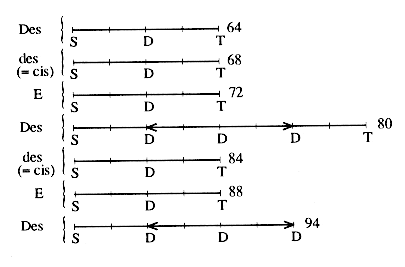
The disturbances in the rhythm of the strophes and phrases, caused by either halting or delaying harmonic progressions might be considered musical analogies to the literary technique of retardation, which relies upon introducing delays in epic development. In the Mazurka in C-sharp minor, Op. 30, No. 4 (m. 5-32) this technique is used to expand the segment in which the main theme of the composition is introduced (see Figure 10).
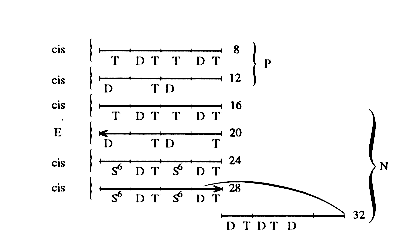
The technique of breaking off a phrase and interjecting motivic figuration between its repeated fragments, which is used in this segment, leads to the considerable stretching of the consequent while simultaneously creating the effect of suspending movement. This effect appears to be a substitute for ending the period, since the consequent is not closed with a cadence. Such closure does not occur until the following strophe, which also carries new thematic material. The doubled dimensions of the thematic segment and above all, the intense dramatization of the musical progression, exemplify a formal arrangement rare among the mazurkas. It is characterized by the absence of the more or less exact repetitions of the main theme.[15]
The use of contrast to dramatize the music may be examined at two levels: (1) within the confines of one musical theme which is developed in two opposing phrases, and (2) on the formal plane, when two different segments of the same composition take on the guise of two conflicting (competing) themes. The Mazurka in E minor, Op. 41, No. 1 (“Palma”) presents a unique case of the simultaneous application of the principle of contrast on both levels. The constant element in this composition is strophe B, whose phrases do not constitute a complete period. The syntactic whole, implied by the presence of an slur, emerges only as a result of connecting strophe B with the theme A which continues to be developed (see Figure 11).[16]

Here, the opposition of themes A and B corresponds with the question and answer relationship, typical of the periodic form and based on the dominant-tonic relationship reinforced by the melodic shape of theme B, seemingly mirroring the intonation of the voice uttering a question.
The juxtaposition of two contrasting segments in one syntactic whole is the main principle of structuring themes in the Mazurkas Opus 41, No. 4 and Opus 50, No. 3. Thus, the main theme of the Mazurka in C-sharp minor, Op. 41, No. 4, has been extended to two strophes connected by the common modulation framework with the keys “C-sharp minor – E major – C-sharp major.” This arrangement plays an essential role in suffusing the whole segment with an evolutionary character. In the Mazurka in C-sharp minor, Op. 50, No. 3, the two-phase musical progression (confined to the framework of one sixteen-measure strophe) affects both themes, A and B.
Hugo Leichtentritt has conceded that Mazurkas Op. 41, No. 4 and Op. 50, No. 3 occupy a unique position in this genre. He also pointed out Chopin’s use of several elements characteristic of the sonata form in these composition and referred to this phenomenon as the “mark of symphonization.”[17] Indeed, it may be said that individual segments of both mazurkas which take on the guises of themes, transitions, and developments, articulate the flow of the music in a manner reminiscent of the “musical action” in the sonata allegro form. However, the themes remain in their respective keys during the recapitulation and the “drama of development” does not take place until the final phase of the composition (see Figure 12).
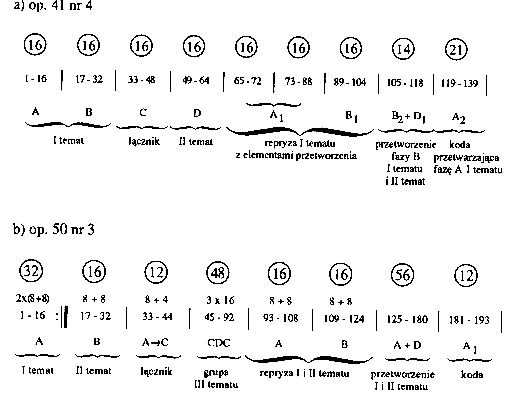
The above diagrams reveal, on the one hand, the strophic structures underlying the formal outlines of both compositions and, on the other hand, the tendency to blur strophic divisions by clustering strophes into larger segments. Due to the role of these segments in shaping the form, they introduce a new partitioning of the music; this segmentation is of a higher order than the one associated with the strophic structure. In order to mask the caesuras between the strophes the superimposition of themes is also used: in this process, motifs from a theme that is to be developed in a subsequent strophe appear already in the preceding strophe, thus anticipating the direction of the development of the music. The effect of this peculiar form of anticipation of the “epic narrative” may be observed in the Mazurka in C-sharp minor, Op. 50, No. 3 (m. 33-45) (see Example 13).

The tendency to transcend the strophic structure, resulting in a departure from the regular, formal segmentation of the classical Taktordnung, emerges clearly beginning with the Mazurkas opus 30. It manifests itself through the manner in which the slur is used “against the phrase.” In the Mazurka in C minor, Op. 30, No. 1, the slur connecting strophes containing dissimilar thematic material (simultaneously neutralizing the closure of the period in m. 15-18) joins two-measure phrases into a less-typical six-measure segment (m. 19-24), and finally introduces the caesura in the course of the phrase as if to emphasize its breakup (m. 25-28). In the Mazurka in G sharp minor, Op. 33, No. 1 (m. 1-48) the slur once more works against segmentation, stemming from the strophic structure, and conforms, in this case, to the cadential punctuation characteristic of the periodic syntax (see diagram (a) in Figure 14). The presence of the slur, however, suggests a different divisibility (see diagram (b) in Figure 14) while highlighting the role of the two-measure cadential formula which also opens the composition. Simultaneously, this two-measure cadential pattern loses its definitive “closing” character and is transformed into a kind of invocation opening each of three “new” segments of the form, as well as each of the outer segments (see Figure 14).

The Mazurka in C minor, Op. 56, No. 3, also included by Leichtentritt in the category of compositions carrying “marks of symphonization” (1921, p. 258), may be considered as am apex of the tendency to liberate the form from the regularity of the strophes, and to release the syntax from the confines of the Taktordnung. This is evident both in the patterns of segmentation where the classical “four-squareness” is abandoned, and in the structure of themes I (A) and III (D). The following diagram illustrates the formal scheme of this composition (see Figure 15).
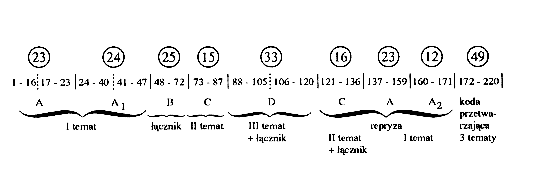
The first theme of the piece (m. 1-23) is developed within a twenty-three-measure segment, including a sixteen-measure strophe composed of two eight-measure sections structured according to the approximate ratio of the “golden section” (3+5/3+5), and arranged following the modulation plan of: C minor – G minor – C minor – D minor. The second eight-measure section is connected to the following phase of the music by the pedal note, which introduces new motivic material (see Example 16).
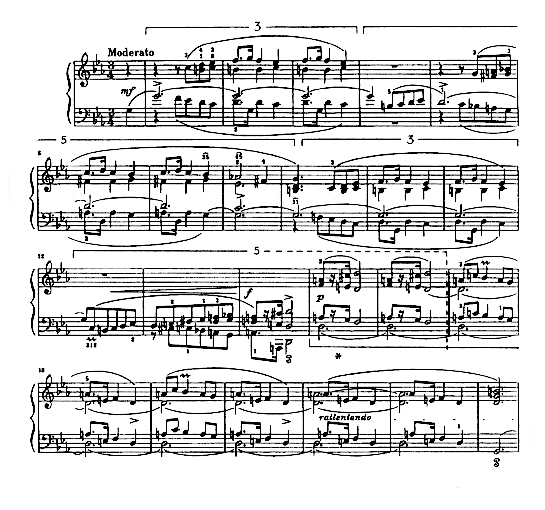
The third theme of this mazurka is similarly constructed; its key is B-flat minor (m. 88-120) and it is incorporated into the second theme in B-flat major (m. 73-87 and m. 121-133) which has a contrasting rhythmic and melodic character. The first part of the third theme forms an irregular eighteen-measure strophe composed of two periods. The first period is contained within an eight-measure section and has a 5+3 phrase structure. The second period is a developmental expansion of the first one, with the consequent extended to four measures and connected with a slur to the following phrase where (as earlier) new thematic material is introduced (m. 88-120) (see Example 17).

In both fragments of the above composition we witness the transformation of themes into thematic groups; this transformation might be regarded as a development of the concept of two-phase thematic progression (in the Mazurkas Op. 41, No. 4, and Op. 50, No. 3). Nonetheless, both fragments also introduce syntactic solutions that have never before been utilized in this form. This syntactic innovation consists on such a shaping of the consequent that allows its smooth transformation into a new musical idea. Incidentally it also corresponds to what A. B. Marx has called the syntactic category of a “period with a resolved consequent” (Die periode mit aufgelösten Nachsatz).[18] The acceptance of this innovation might be regarded as the cause of Chopin’s departure from the classical symmetry of the Taktordnung.
In formal terms, it is apparent that the Mazurka in C minor, Op. 56, No. 3, continues the principles formulated in the Mazurkas Op. 41, No. 4 and Op. 50, No. 3. Their conceptual relationship may be seen in the introduction of an expansive developmental coda which appears after the recapitulation and begins with the reinstatement of the first theme, limited to only one phase. In the Mazurka in C minor the coda may be seen as a polyphonic synthesis of all three themes.
The Mazurka in C minor, Op. 56, No. 3 constitutes a climactic point in the process of transformation of Chopin’s musical language within the framework of the mazurkas. This process led him away from the regularity of classical periodic patterns towards free structures in which the melodic and harmonic elements are liberated from the rigors of the Taktordnung and shape the syntax according to expressive requirements. The subordination of the metric principle to syntax played a fundamental role in this process.
IV.
An entirely different set of events occurs in these mazurkas where the metric principle is the dominating factor, while the cadential “punctuation” within the period is of secondary importance. This arrangement primarily concerns compositions which have an oberek-like character, clearly referring to a folk-dance pattern and thus acquiring traits of the character dances. Here, periodic syntax is usually neutralized by the use of phrases which are melodically homogeneous and have well-defined rhythmic contours (Mazurkas: Op. 6, No. 4; Op. 7, No. 5; Op. 24, No. 2; Op. 33, No. 2). Here the consequent is frequently an exact repetition of the antecedent. The introduction of the pedal note (Op. 6, No. 4) or sustained bourdon sonorities (Op. 56, No. 2) causes the harmony to lose its importance as an element of punctuation. The modal elements (e.g., references to the Lydian mode in Op. 24, No. 2, m. 21-36) have a similar effect upon syntax. All the above compositions have a distinct strophic structure combined with the segmentation articulated by prominent tonal contrasts (e.g., in the Mazurka Op. 24, No. 2: C major – D-flat major – C major; or in the Mazurka Op. 33, No. 2: D major – B-flat major – D major). These traits tend to highlight the element of tone color, accompanied with a particular tendency to a “geometrization” of symmetric form.
This tendency is at its apex in the previously mentioned Mazurka in B major Op. 41, No. 2. The suppression of the periodic syntax (it serves merely as a distant point of reference) causes the apparent absence of thematic material in this composition. The “geometry of the strophe” becomes its central formative element because the absence of the theme(s) in the individual segments of part A allows for the almost mechanical transformation of these segments in the recapitulation. The Mazurka in B major, Op. 56, No. 1, represents a unique experiment: blurred cadential punctuation, partial departure from the Taktordnung and the masking of the strophic structure all occur simultaneously. In the twenty-two-measure segment, that contains the main theme of this composition, five sections can be identified. They include five, four, four, six, and three measures arranged according to the modulation scheme of B major – G major – B major (m. 1-22). The caesuras between cadences are blurred by the binary rhythm of the phrase, emphasized in the first eight measures by slurring. The structure of this segment is ambiguous enough to allow for various modes of its partitioning. Leichtentritt interpreted it as a pattern of 2+2+1/4+3/8+2 (1921, p. 54), while Miketta saw a period consisting of a b b’ a’ divided into 4+4+4+10 measures (1949, p. 84). In segment B (m. 45-80) the steady rhythm of the eight-note figuration blurs cadential interruptions and removes the caesura between the strophes (m. 60-61). The textural and tonal contrast (B major – E-flat major – B major – G major – B major) between segments A and B, dominating both the periodic syntax and strophic structure, is the main factor defining the form in this composition. The following diagram represents the formal outline of the Mazurka in B major (see Figure 18).

The Mazurka in C major, Op. 56, No. 2, is the only work in this opus that truly highlights the unique characteristics of this genre. It is also Chopin’s last mazurka which so clearly alludes to the folk archetype; it provides an insight into his method of “liberating” the element of tone color that becomes the dominant element in the segment that precedes the recapitulation of the thematic strophe (m. 53-68; see Example 19).
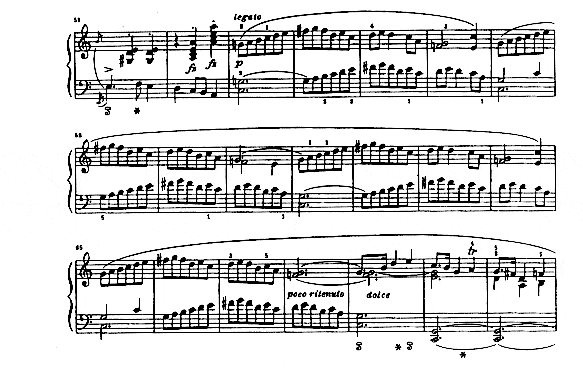
The use of canonic imitation and vivace tempo leads to the creation of an effect of the almost mechanical shift of a distinctly shaped and regular four-verse strophe. In this way the strophe loses its syntactic and metrical contour and is transformed into a segment playing a primarily coloristic function.
V.
One might have expected that mazurkas representing after all, a category of stylized dance, would be a natural stronghold for classical periodic structure, where regular segmentation, clear phrasing rhythms, and audible syntax are protected by laws defining the properties of this genre. Indeed, each opus of the Mazurkas includes at least one composition which adheres to all the above conditions and plays the role of the “genre sample.” Nonetheless, the original or sometimes even “exotic” guise of a dance lends itself to the search and experimentation, which eventually led to the “undoing” of the periodic structure. In this context one sees, even in the earliest mazurkas, a continuing and consistent creative effort, the result of which is the richness of stylistic means coupled with their precise and effective use.
This quality of Chopin’s creative personality has a rather discouraging effect on whose who would attempt yet another classification of the mazurkas, even more so because—to quote Jeffrey Kallberg—”numerous attributes of his mature style already appear in Chopin’s earliest compositions and are only refined during the following years.”[19] Such a statement (I limit it here solely to the mazurkas) is essentially tantamount with the recognition of the stylistic coherence, based on the a continuous development of a distinct set of structural ideas. New solutions, at first cautiously introduced, are tried in various contexts, and once transformed into the permanent elements of style they rarely become obsolete. In such a case the stylistic transformation can be reduced to a perpetual expansion of the composer’s “playing field” in a direction predetermined by once accepted compositional principles.
We could assume that one of these objectives was to penetrate the possibilities locked in the periodic structure. Choosing the classical norm as a point of reference, we may conclude that the first element of the periodic structure to be transformed and developed was the relationship between the antecedent and consequent. Beginning with the mazurkas of Op. 7 (1824-32) we notice the presence of techniques that blur this relationship while preserving the remaining elements of the periodic structure. In this opus there are the first indications of on alternate course of action. What occurs is a weakening of the caesura between different periods with a simultaneous emphasis on the antecedent-consequent relation. The essential element of this alternate method is the shift of the caesura, resulting from the expansion of one segment (usually the second one) or the periodic structure. The displacement of the caesura may serve to expand the period within the strophe while preserving the ratio between the segments (the earliest example is Mazurka in E minor, Op. 17, No. 2, 1833). It may also disturb the original rhythm of the strophe (see the Mazurka in B-flat minor, Op. 24, No. 4, 1833).
The development of the compositional techniques which served to weaken, mask or displace the inter-period caesura, made possible the creation of syntactic structures “above and beyond” the strophe. The most subtle of these techniques is the slurring “against the phrase,” which is essentially directed against the cadential punctuation and the Taktordnung; the use of this technique may at times reorganize the entire form of the composition. This type of sluring initially appears in the small compositions from Op. 30 and Op. 33 (1837-38). The slur announces the imminent arrival of a more potent technique, namely the use of a harmonic plan connecting segments with distinct motivic material into one syntactic whole. The presence of this formative principle may be noticed in mazurkas published in Op. 41 (1838-39) and later pieces.
The last element of the periodic structure to undergo a transformation in Chopin’s mazurkas was the Taktordnung. An early indication of these experiments may be recognized in the manner of slurring found in the Mazurka in G-sharp minor, Op. 33, No. 1 and in the segmentation of the Mazurka in B major, Op. 42, No. 2. However, in both compositions only the regularity and “four-squareness” of the Taktordnung were altered; the binary principle which organized the flow of the musical material and, simultaneously, defined the pulsation of the periodic rhythm, remained intact. This binary principle was first undermined in the Mazurka in C minor, Op. 56, No. 3 (1843-44): (1) in the development of the theme that was presented in an atypical framework of twenty-three measures, and (2) in the eight-measure segments based on the “golden section” divisions that interfered with the binary principle. It is worth noting that this innovation, significant enough to be recognized as a stylistic breakthrough, did not firmly take hold in Chopin’s music and did not reappear in any of the later mazurkas published during the composer’s lifetime.
While attempting to define the aesthetic essence of these transformations one should return to the classical concept of the periodic structure that might be considered a kind of grammar of musical language. It transforms music into a “language of sounds” and turns a musical passage into a more or less distant approximation of an ideal “verbal archetype,” thus allowing music to be considered in terms borrowed from literary theory, for instance narrative, lyric, epic, drama, etc. While accepting this point of view we should note that emphasizing the antecedent—consequent relationship while simultaneously masking or shifting the end of the period, as well as expanding the phrase while disturbing its rhythm, intensifies the expressive traits of the “language of sounds,” and leads to the dramatization of the form. On the other hand, the blurring of the antecedent—consequent relationship, while stressing the metric principle results in the weakening of the connections between the “sounds” and the “language” and emphasizes the “abstract” characteristics of the musical form. These two extremes define the realm of the diversity of the genre. This diversity, present in the mazurkas from the earliest opus numbers, reaches its apex in the Mazurkas Opus 41 (no 1 and, No. 2) and Opus 56 (no 2 and, No. 3). It is then considerably diminished in Opus 59 and Opus 63.
In the brilliant compositions from the Opus 59 (1845) Chopin combined his innovations with traits characteristic of the genre. The easily discernible periodic syntax is ideally harmonized with the creative use of versification, particularly in the twenty-four-measure segment B of the Mazurka in A-flat major, Op. 59, No. 2 (m. 45-68), where the strophic ratio is (3 x 4+3): (3+2+3). In this division the elements of the “golden ratio” (15:9 = 5:3) may be detected. The same traits are also present in the thirty-six-measure segment B of the Mazurka in F-sharp minor, Op. 59, No. 3 (m. 45-80) with the arrangement of phrases 4+6+4+6/6+4+6. Diverse phrasing rhythms, varied slurring of the repeated sections, expansion and superimposition (layering) of the phrases—all these techniques both blur the strophic structure and influence the greater dynamism of the music, while not disturbing the higher-level segmentation that respects the framework of the classical Taktordnung. The final consequence of the synthesis reached here is a harmonious balance between the elements of dance, lyricism and drama in each of the Mazurkas Opus 59.
The Mazurkas from Opus 63 (1846) are characterized by a clear tendency leading to a gradual re-miniaturization of the for and toward the reduction and simplification of compositional means while simultaneously concentrating on classical elements of the “language of sounds.” These Mazurkas were created at a time of creative experiments aimed at a transformation of Chopin’s compositional style. According to Jeffrey Kallberg’s (1986, p. 56) convincing hypothesis, the Mazurka in F minor, Op. 68, No. 4 (“the last one”) could have been composed in this period. This mazurka is really an abandoned sketch, an unfinished proof of an unsuccessful attempt to reconcile the new compositional principles with the elements defining this particular genre. In the first segment of this composition our attention is called to a peculiar treatment of the elements of periodic structure. Both the enclosure of the segment within a framework of the twenty-three measures, and the way in which “the ideal” eight-measure section is developed as “a period with an open consequent” suggest that this sketch could have been an attempt to establish a link with the innovations introduced in Mazurka in C minor, Op. 56, No. 3.
Notes
[1]. Wolfgang Budday, Grundlagen musikalischer Formen der Wiener Klassik. An Hand der zeitgenossischen Theorie von Joseph Riepel und Heinrich Christoph Koch dargestellt an Menuetten und Sonatensatzen (1750-1790). Reprint. (Kassel-Basel, London, 1983), 76.[Back]
[2]. Riepl quoted in Budday, Grundlagen, 47. See also Carl Dahlhaus, “Periode” in Riemann Musik-Lexicon (Sachteil), ed. Hans Heinrich Eggebrecht (Mainz 1967), 721-722. [Back]
[3]. See Budday, Grundlagen, 21; Dahlhaus, “Periode,” 721-722, and Józef Chomiński and Krystyna Wilkowska-Chomińska, Formy muzyczne [Musical forms], vol. 1 (Kraków: PWM, 1983), 177-221, details on p. 208. Józef Chomiński and Krystyna Wilkowska-Chomińska apply the concept of the “period” only to those phrasing arrangements that reveal a clear framework of the “question and answer.”[Back]
[4]. Julian Krzyżanowski, Nauka o literaturze [Literary Research] (Wrocław: Ossolineum, 1984), 149. [Back]
[5]. Janusz Miketta, Mazurki Chopina(Kraków: PWM, 1949); Chomiński and Wilkowska-Chomińska, Formy muzyczne, 208. [Back]
[6]. William Rothstein, “Phrase Rhythm in Chopin’s Nocturnes and Mazurkas,” in Chopin Studies, ed. Jim Samson, (Cambridge: Cambridge University Press, 1991), 115-141, especially p. 128. [Back]
[7]. Thomas Higgins, “Znak łuku Chopina” [The sign of Chopin’s slur], Rocznik Chopinowski vol. 12 (1980); Rothstein, “Phrase rhythm,” 124 ff. [Back]
[8]. Adolph Bernard Marx, Die Lehre von der musikalischen Komposition, 4 vols. (Leipzig 1837-1847), 194; Carl Dahlhaus, “Der rhetorische Formbegriff H. chr. Kochs und die Theorie der Sonatenform,” Archiv fur Musikwissenschaft vol. 35, no. 3 (1978). [Back]
[9]. See Budday, Grundlagen, 129. For an analysis of this phenomenon see Chomiński and Wilkowska-Chomińska, Formy muzyczne, 212-213. [Back]
[10]. The same segmentation is also given by Miketta, Mazurki Chopina, 62. Leichtentritt (p. 208), however, recognizes in this segment the existence of three four-measure phrases; he considers the whole as a period with an extended consequent. [Back]
[11]. Irena Poniatowska, Muzyka fortepianowa pianistyka w wieku XIX. Aspekty artystyczne i społeczne [Piano music and piano study in the 19th century. Social and Artistic Aspects] (Warsaw, 1991), 207-208. She quotes the first segment of this mazurka as an example of instability of the classical periodic structure. See also Heinrich Schenker, Anhang (1954), 14. [Back]
[12]. Chomiński and Wilkowska-Chomińska, Formy muzyczne, 211-212. See also Miketta, Mazurki, 142-143. [Back]
[13]. Chomiński and Wilkowska-Chomińska discussed Chopin’s method of creating periods of a higher order on the basis of his Mazurka in F-sharp minor, Op. 6, No. 1; Formy muzyczne, 221. [Back]
[14]. Dahlhaus, “Periode,” 159, 337.[Back]
[15]. Jeffrey Kallberg, “The Problem of Repetition and Return in Chopin’s Mazurkas,” in Chopin Studies, ed. Jim Samson (Cambridge University Press, 1988), 5, 15. Kallberg demonstrated the existence of a connection between the “evolutionary” introduction of the theme and the resignation from the repetition of the thematic segment on the basis of the Mazurka in B-flat minor, Op. 24, No. 4. [Back]
[16]. On the basis of his analyses of Chopin’s corrections for measures 33-36, Kallberg (“Problem of Repetition,” 14) interprets its form as th sequence of A B C B A. [Back]
[17]. Leichentritt, 208, 241, 250.
[18]. “Die Periode mit aufgelostem Nachsatz; es wird namlich ein regelmassiger Vordersatz geblidet, der Nachsatz aus den Motiven desselben begonnen, dann aber nicht zum periodischen Abschlusse gebracht, sondern gangartig weiter gefuhrt zum Seitensatze” (A. B. Marx, Die Lehre, vol. 3, 251. [Back]
[19]. Jeffrey Kallberg, “Ostatnia przemiana stylu Chopina,” [The last transformation of Chopin’s style], Rocznik Chopinowski vol. 18 (1986): 17. [Back]
Dr. Witkowska-Zaremba, born in 1946, is a Polish musicologist and classicist. At present, she works at the Institute of Polish Arts of the Polish Academy of Science in Warsaw and serves on the editorial board of the Polish Musicological Quarterly, Muzyka. She is the author of the following books: Ars Musica w krakowskich traktatach muzycznych XVI w. (Kraków 1986), and Musica Muris i nurt spekulatywnych w muzykografii średniowiecznej” (Warsaw 1992).